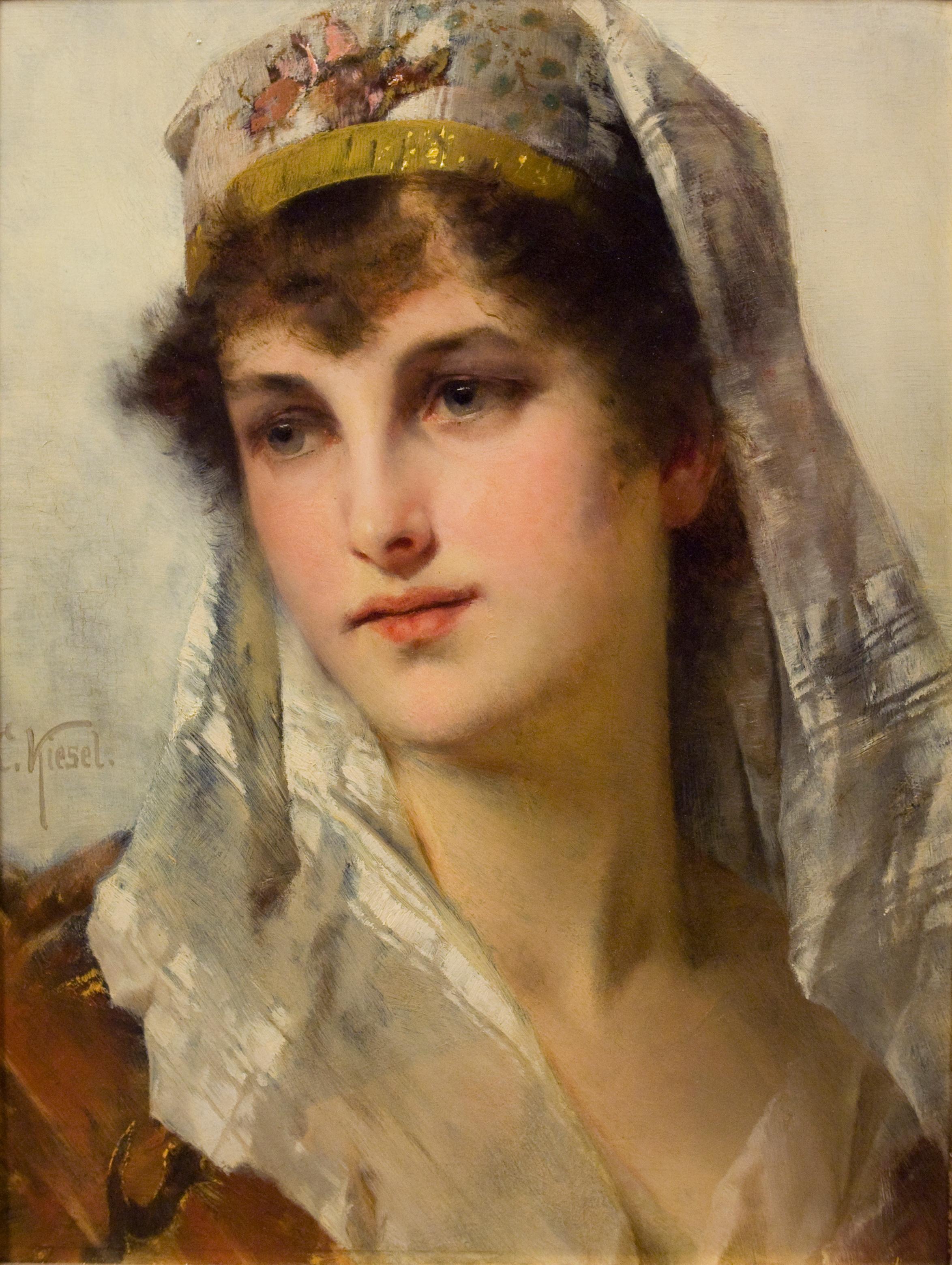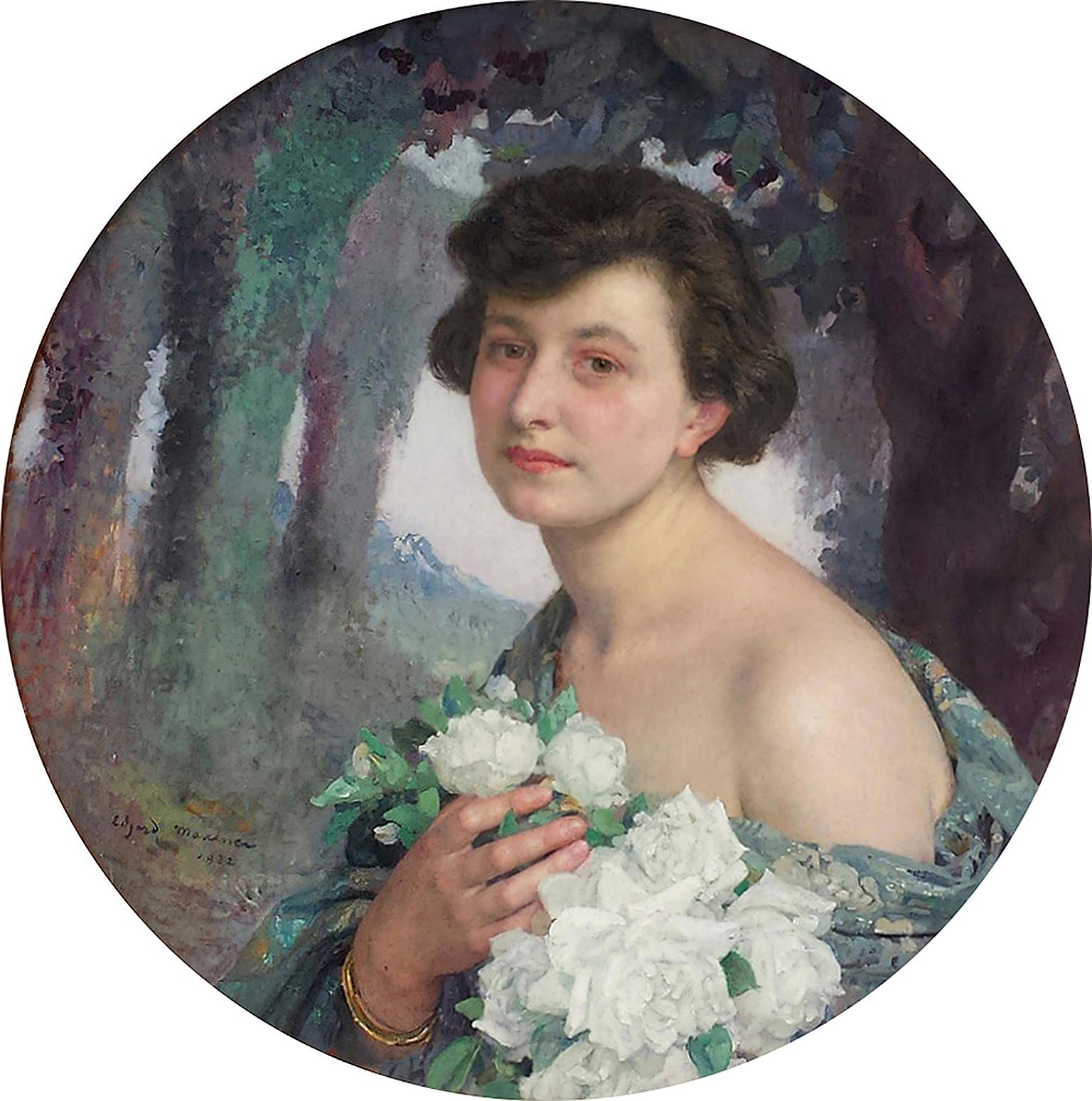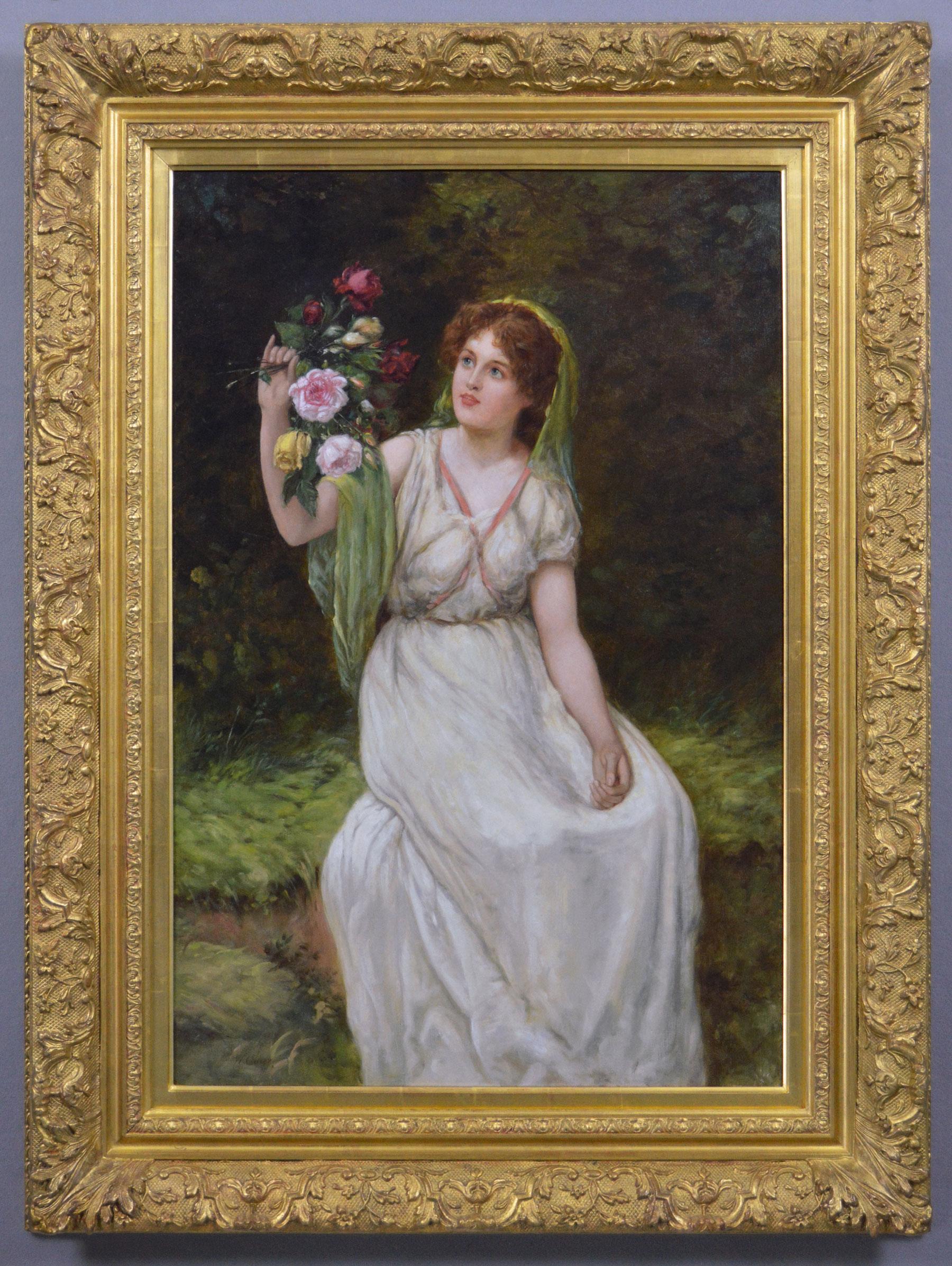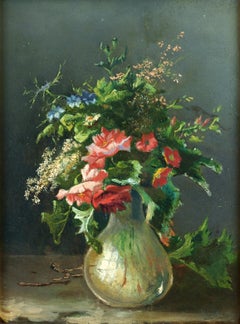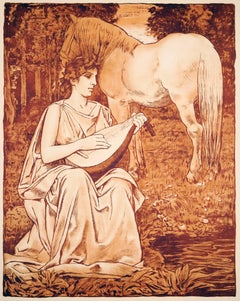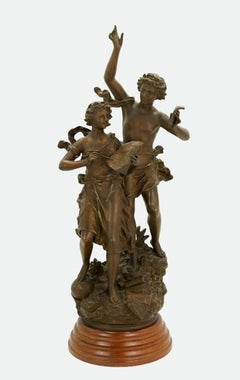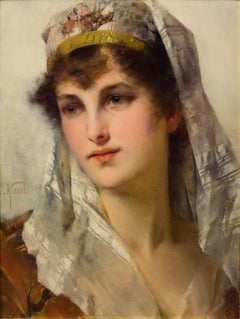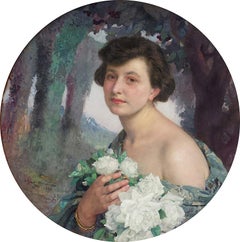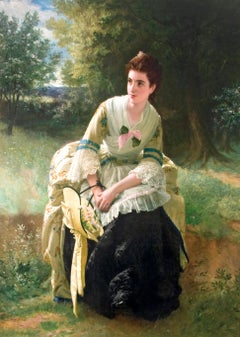Items Similar to The gift of flowers / - The depth of allegory -
Video Loading
Want more images or videos?
Request additional images or videos from the seller
1 of 11
Conrad KieselThe gift of flowers / - The depth of allegory -c. 1900
c. 1900
$11,481.30
$14,351.6320% Off
£8,470.03
£10,587.5420% Off
€9,600
€12,00020% Off
CA$15,894.05
CA$19,867.5620% Off
A$17,233.80
A$21,542.2520% Off
CHF 9,145.77
CHF 11,432.2220% Off
MX$212,256.17
MX$265,320.2120% Off
NOK 113,356.12
NOK 141,695.1420% Off
SEK 106,982.11
SEK 133,727.6420% Off
DKK 73,089.91
DKK 91,362.3820% Off
About the Item
Conrad Kiesel (1846-1921), The gift of flowers. Oil on wood, 43 x 35 cm, 69 x 61 cm (frame), signed at lower left "Conrad Kiesel pxt [pinxit]", about 1900. In a magnificent gilt stucco frame of the period. With an old London gallery label on the reverse.
- Major retouching by the artist himself to lighten the incarnate. The painting is in very good condition, the frame partially rubbed and bumped.
- The depth of allegory -
At first glance, Conrad Kiesel illustrates Flora, the goddess of blossom and spring, and yet the figure depicted does not fit into the traditional iconography. Flora has neither black hair nor does she wear a laurel wreath. Based on traditional imagery, Conrad Kiesel creates a novel allegory that includes eros, death, and the triumph of art over death alongside the unfolding of life.
The flowers illustrate the blossoming life whose beauty is before our eyes in the young woman. The flowers seem to formally turn towards her, and her antiquing gray-blue robe has a folded structure related to the flowers, so that it in turn seems like a calyx of blossoms from which the youthful beauty emerges. The garment not only allows a view of her upper arm, which animates the imagination of the shoulder and the tracing of the elegant neck line, where the two pink chrysanthemums 'look' at the youthful beauty, the garment is translucent, so that her breast becomes visible in a game of concealment and revelation.
The blossoming life imbued with Eros is contrasted by the black hair and dark eye sockets, allegorically introducing the dimension of death into the motif. But the young woman is also crowned with the laurel wreath of eternal glory, so that the flora becomes Victoria, illustrating that glory overcomes death. At the same time, the laurel wreath is also a symbol of poetry, making the young woman the personification of poetry and inspiration, as well as a muse. Consistent with this aspect of eternity, which refers to art itself, the yellowish background appears like a golden ground, against which the young woman appears like a saint.
Conrad Kiesel was especially sought after as a portraitist. In this painting, in which he did not follow a portrait commission, he had the freedom to follow his own pictorial ideas completely. He created a multi-layered allegory whose mysterious appeal lies in the fact that it cannot be definitively resolved.
The painting is an excerpt and allegorical intensification of his picture 'Die Margareten' in the Manchester Art Gallery, which in variation was also converted into painting by the Königliche Porzellan-Manufaktur (KPM).
While the oriental beauty is hawking the flowers there, the young woman in our picture takes two yellow flowers from the bouquet with an elegant gesture in order to offer them to the one whom her gaze has chosen and whose name her sensually open mouth already seems to pronounce.
The change from oriental beauty to allegory explains the retouching done to lighten the incarnate. This sensitivity to color is also evident in the decision to have the young woman remove two yellow flowers from the otherwise pink bouquet. Combined with the gray-blue of the garment, this creates a subtle, well-balanced tension of color.
About the artist
Conrad Kiesel first studied architecture at the Royal Academy of Architecture in Düsseldorf, but then transferred to the Berlin Academy of Arts to study sculpture with Fritz Schaper. After working as a sculptor for six years, he decided to become a painter, inspired by a trip to Holland. He was first a student of Fritz Paulsen in Berlin, then moved to Düsseldorf to study under Wilhelm Sohn.
"With Wilhelm Sohn he acquired colouristic skills which he quickly developed to the highest virtuosity, namely in the treatment of shiny silk and atlas fabrics".
Adolf Rosenberg
After a stay in Munich, Conrad Kiesel settled in Berlin in 1885 and became a sought-after society and portrait painter in the highest circles. He painted portraits of Wilhelm II and the Empress Augusta. In 1886 he was appointed Royal Professor.
He was awarded the gold medal several times at the exhibitions of the Berlin Academy. His works were regularly exhibited at the Academy exhibitions in Düsseldorf and Vienna and at the Glass Palace in Munich. Internationally, he exhibited at the Royal Academy of Arts and was represented in 1910 at the Paris, and 1911 at the Roman World's Fair.
GERMAN VERSION
Conrad Kiesel (1846-1921), The gift of flowers. Oil on wood, 43 x 35 cm, 69 x 61 cm (frame), signed at lower left "Conrad Kiesel pxt [pinxit]", about 1900. In a magnificent gilt stucco frame of the period. With an old London gallery label on the reverse.
- Major retouching by the artist himself to lighten the incarnate. The painting is in very good condition, the frame partially rubbed and bumped.
- The depth of allegory -
At first glance, Conrad Kiesel illustrates Flora, the goddess of blossom and spring, and yet the figure depicted does not fit into the traditional iconography. Flora has neither black hair nor does she wear a laurel wreath. Based on traditional imagery, Conrad Kiesel creates a novel allegory that includes eros, death, and the triumph of art over death alongside the unfolding of life.
The flowers illustrate the blossoming life whose beauty is before our eyes in the young woman. The flowers seem to formally turn towards her, and her antiquing gray-blue robe has a folded structure related to the flowers, so that it in turn seems like a calyx of blossoms from which the youthful beauty emerges. The garment not only allows a view of her upper arm, which animates the imagination of the shoulder and the tracing of the elegant neck line, where the two pink chrysanthemums 'look' at the youthful beauty, the garment is translucent, so that her breast becomes visible in a game of concealment and revelation.
The blossoming life imbued with Eros is contrasted by the black hair and dark eye sockets, allegorically introducing the dimension of death into the motif. But the young woman is also crowned with the laurel wreath of eternal glory, so that the flora becomes Victoria, illustrating that glory overcomes death. At the same time, the laurel wreath is also a symbol of poetry, making the young woman the personification of poetry and inspiration, as well as a muse. Consistent with this aspect of eternity, which refers to art itself, the yellowish background appears like a golden ground, against which the young woman appears like a saint.
Conrad Kiesel was especially sought after as a portraitist. In this painting, in which he did not follow a portrait commission, he had the freedom to follow his own pictorial ideas completely. He created a multi-layered allegory whose mysterious appeal lies in the fact that it cannot be definitively resolved.
The painting is an excerpt and allegorical intensification of his picture 'Die Margareten' in the Manchester Art Gallery, which in variation was also converted into painting by the Königliche Porzellan-Manufaktur (KPM).
While the oriental beauty is hawking the flowers there, the young woman in our picture takes two yellow flowers from the bouquet with an elegant gesture in order to offer them to the one whom her gaze has chosen and whose name her sensually open mouth already seems to pronounce.
The change from oriental beauty to allegory explains the retouching done to lighten the incarnate. This sensitivity to color is also evident in the decision to have the young woman remove two yellow flowers from the otherwise pink bouquet. Combined with the gray-blue of the garment, this creates a subtle, well-balanced tension of color.
About the artist
Conrad Kiesel first studied architecture at the Royal Academy of Architecture in Düsseldorf, but then transferred to the Berlin Academy of Arts to study sculpture with Fritz Schaper. After working as a sculptor for six years, he decided to become a painter, inspired by a trip to Holland. He was first a student of Fritz Paulsen in Berlin, then moved to Düsseldorf to study under Wilhelm Sohn.
"With Wilhelm Sohn he acquired colouristic skills which he quickly developed to the highest virtuosity, namely in the treatment of shiny silk and atlas fabrics".
Adolf Rosenberg
After a stay in Munich, Conrad Kiesel settled in Berlin in 1885 and became a sought-after society and portrait painter in the highest circles. He painted portraits of Wilhelm II and the Empress Augusta. In 1886 he was appointed Royal Professor.
He was awarded the gold medal several times at the exhibitions of the Berlin Academy. His works were regularly exhibited at the Academy exhibitions in Düsseldorf and Vienna and at the Glass Palace in Munich. Internationally, he exhibited at the Royal Academy of Arts and was represented in 1910 at the Paris, and 1911 at the Roman World's Fair.
- Creator:Conrad Kiesel (1846 - 1921)
- Creation Year:c. 1900
- Dimensions:Height: 27.17 in (69 cm)Width: 24.02 in (61 cm)Depth: 3.15 in (8 cm)
- Medium:
- Movement & Style:
- Period:
- Condition:
- Gallery Location:Berlin, DE
- Reference Number:1stDibs: LU2438213065922
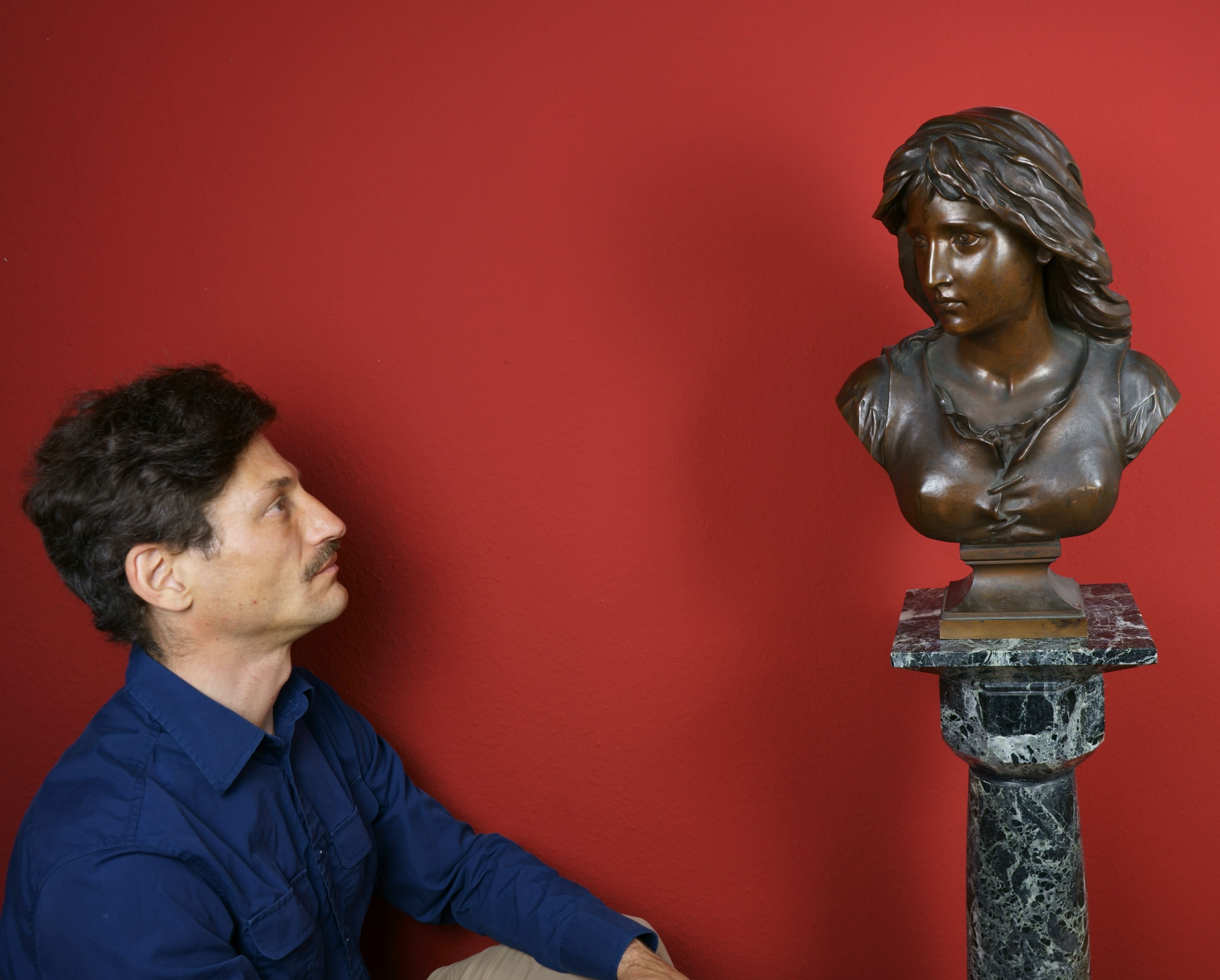
About the Seller
5.0
Vetted Professional Seller
Every seller passes strict standards for authenticity and reliability
Established in 2014
1stDibs seller since 2023
21 sales on 1stDibs
- ShippingRetrieving quote...Shipping from: Berlin, Germany
- Return Policy
Authenticity Guarantee
In the unlikely event there’s an issue with an item’s authenticity, contact us within 1 year for a full refund. DetailsMoney-Back Guarantee
If your item is not as described, is damaged in transit, or does not arrive, contact us within 7 days for a full refund. Details24-Hour Cancellation
You have a 24-hour grace period in which to reconsider your purchase, with no questions asked.Vetted Professional Sellers
Our world-class sellers must adhere to strict standards for service and quality, maintaining the integrity of our listings.Price-Match Guarantee
If you find that a seller listed the same item for a lower price elsewhere, we’ll match it.Trusted Global Delivery
Our best-in-class carrier network provides specialized shipping options worldwide, including custom delivery.More From This Seller
View AllStill life with meadow flowers - The beauty of meadow flowers -
Located in Berlin, DE
Jean-Baptiste Robie (1821 Brussels - 1910 ibid.). Still life with meadow flowers. Oil on wood, 24.5 x 18.5 cm (inside measurement), 37 x 31 cm (frame), signed and dated (difficult to...
Category
Early 1900s Naturalistic Still-life Paintings
Materials
Oil, Canvas
$3,053 Sale Price
20% Off
Muse / - In the realm of the muses -
Located in Berlin, DE
Hans Thoma (1839 Bernau - 1924 Karlsruhe), Muse, 1893. Algraph on strong wove paper, published by Breitkopf und Härtel in Leipzig as ‘Zeitgenössisches Kunstblatt Nr. 174’, 43.5 cm x ...
Category
1890s Realist Figurative Prints
Materials
Paper
Psyche / - Fulfilled longing -
Located in Berlin, DE
Jan Jozef Jaquet (1822 Antwerp - 1898 Brussels), Psyche, 1847. Black-brown and brown patinated bronze on a cast base. 30 cm (height) x 22 cm (width) x 12 cm (depth), weight 5 kg. Ver...
Category
1840s Realist Figurative Sculptures
Materials
Bronze
$1,435 Sale Price
20% Off
Allegory of Progress / - The Driving Force of Inspiration -
Located in Berlin, DE
Ernest Rancoulet (1842-1918), Allegory of Progress, around 1890. Bronze-plated metal cast with cast terrain plinth mounted on a wooden base (6 cm high). 64.5 cm (total height) x 28 c...
Category
1890s Realist Figurative Sculptures
Materials
Metal
Bust of a young woman / - The Opulence of Beauty -
Located in Berlin, DE
Anton Nelson (i.e. Antoine Joseph van den Kerckhoven) (1849 Brussels - after 1910 ibid.), Bust of a young woman, c. 1890. Patinated bronze on cast base, 30 cm (total height) x 20 cm ...
Category
1890s Art Nouveau Figurative Sculptures
Materials
Bronze
Reading Woman / - The golden glow of imagination -
By Albert-Ernest Carrier-Belleuse
Located in Berlin, DE
Albert-Ernest Carrier-Belleuse (1824 Anizy-le-Château - 1887 Sèvres), Reading Woman, around 1880. Polished bronze mounted on a cast base. 33 cm (total height) x 9 cm (length) x 9 cm ...
Category
1880s Realist Figurative Sculptures
Materials
Bronze
$2,296 Sale Price
20% Off
You May Also Like
Young Beauty
By Conrad Kiesel
Located in Mc Lean, VA
An Orientalist figurative or genre painting by Conrad Kiesel.
Category
Mid-19th Century Academic Figurative Paintings
Materials
Oil, Wood Panel
$11,800
Elegant Woman holding White Roses Flowers , Portrait Champetre French Symbolist
By Edgar Maxence
Located in Miami, FL
Masterfully painted portrait with rich paint surface by the famous French Symbolist Signed and dated lower left Provenance: Waterhouse & Dodd, London ...
Category
1920s Symbolist Portrait Paintings
Materials
Oil, Wood Panel
$58,000 Sale Price
26% Off
Elegant Woman holding White Roses Flowers , Portrait Champetre French Symbolist
By Edgar Maxence
Located in Miami, FL
Masterfully painted portrait with rich paint surface by the famous French Symbolist Signed and dated lower left Provenance: Waterhouse & Dodd, London ...
Category
1920s Symbolist Portrait Paintings
Materials
Oil, Wood Panel
Flower Gathering
By William Oliver
Located in Mc Lean, VA
Signed and dated '1873' lower left
Category
1870s Academic Figurative Paintings
Materials
Canvas, Oil
19th Century genre oil painting of a young woman with roses
By William Oliver
Located in Nr Broadway, Worcestershire
William Oliver
British, (1823-1901)
A Bouquet of Roses
Oil on canvas, signed
Image size: 36 inches x 24 inches
Size including frame: 47.25 inches x 35.25 inches
A wonderful three q...
Category
19th Century Figurative Paintings
Materials
Canvas, Oil
19th Century Oil Painting of Young Belle Epoque Beauty Portrait of Flower Girl
Located in Gerrards Cross, GB
‘Young Beauty holding a Red Rose’ by Étienne Adolphe Piot (1831-1910).
Academy Fine Paintings is fully conversant with the latest US Government import duties and the legal exemptio...
Category
Late 19th Century French School Portrait Paintings
Materials
Oil
